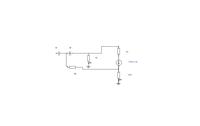obrien135
Full Member level 5
- Joined
- Nov 10, 2009
- Messages
- 240
- Helped
- 5
- Reputation
- 10
- Reaction score
- 5
- Trophy points
- 1,298
- Location
- Connecticut
- Activity points
- 3,259
**broken link removed**
The above link shows a circuit that I am trying to redesign using a more readily accessable transister. Therefore I am try to getthe jist of how it was designed. I tried to develop a set of equations that would describe how the feedback resister affects the pole and zero placement and how it would have the effectthat they described. Maybe you could enlighten me. So far what I got for the transfer function is vo/vi=(Asc3+vbc3c4s^2)/(numerator+Asc4+A/R1+(sc4(vb-(hfe+1)Re))/R1), where A=(vb/(hie+(hfe+1)Re)+vb/(R2||R3)). Is this anywhere near right? How else can I express vb?
The above link shows a circuit that I am trying to redesign using a more readily accessable transister. Therefore I am try to getthe jist of how it was designed. I tried to develop a set of equations that would describe how the feedback resister affects the pole and zero placement and how it would have the effectthat they described. Maybe you could enlighten me. So far what I got for the transfer function is vo/vi=(Asc3+vbc3c4s^2)/(numerator+Asc4+A/R1+(sc4(vb-(hfe+1)Re))/R1), where A=(vb/(hie+(hfe+1)Re)+vb/(R2||R3)). Is this anywhere near right? How else can I express vb?
